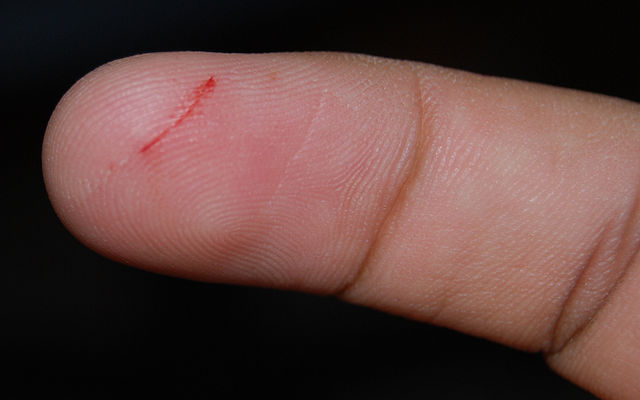Why Paper Cuts Hurt So @%^$@ Much

You probably don’t need an explanation as to how the injury pictured above happens. And you probably don’t need to be told how much they hurt — so, so much, especially given the relatively tiny injury to a body part which is generally rather hardy. So, let’s talk about why this happens.
First, why do we get paper cuts in the first place? How can a sheet of paper slice our skin in a way that a much sharper, otherwise more dangerous item never could?
The short answer is that the edges of paper are actually pretty sharp, even if the sheet as a whole isn’t. Rub your finger slowly over the edge next time you get a chance (slowly! don’t get a paper cut on my account!) and you’ll intuitively understand the risk it entails. According to Wikipedia, when paper sheets are “strongly fashioned together” — such as out of a fresh ream of paper — they’re more likely to cause you harm, so caveat paper-user. (There needs to be a good Latin word for that.)
The cause of the pain, though — that’s much less straightforward. There are a few theories.
One potential culprit is the location of the injury. Our hands (and in particular, our fingers) have a large number of nociceptors — ABC News describes them as “the nerve fibers that send touch and pain messages to our brain” — and a high density of nociceptors to boot. The paper cut stimulates a lot of nociceptors and therefore our brains get a disproportionately high indicator of pain. And really, that’s what pain is — a message from our brains telling us to freak out (and ideally, stop what we’re doing or get help).
On top of that, the paper isn’t a smooth edge like a razor blade is, as mental_floss observes. At a microscopic level, paper’s edges are jagged and, therefore, act like a teeny-tiny buzz saw through a field of pain receptors, making a proportionally large number of similarly tiny cuts along the way. And then there’s the question of the leave-behinds. Indiana Public Media’s “A Moment of Science” points out that some of paper’s component parts are often left behind within the cut (this isn’t true when talking about a metal razor blade), and as the wound heals, these foreign objects jab and prod at the injury from within.
To make matters worse, paper cuts rarely bleed very much, because they’re so shallow and our skin in that area is generally thick. The lack of blood means that there’s little opportunity for a blood clot to form, protecting the wound. As we use the injured finger, there’s a very large chance the cut will re-open, exposing the same nociceptors to the air, and triggering the “ouch!” message once again.
But if it’s any solace, the next time you cut your finger, you’ll be able to go through the theories as to why it hurt so much — a few seconds after you’re done prattling off some expletives.
Bonus fact: This isn’t really related, but it is about pain, charitably speaking. In the 1980s, a sitcom named Growing Pains, reached millions of viewers in the United States each week, and soon found viewers internationally as well. Most of the international titles were similar to the U.S. one; for example, the Spanish version translated to “The problems grow.” But in Italy, the title became Genitori in blue jeans — literally, “parents in blue jeans.” Here’s the title sequence, which Americans will find familiar for the first 57 seconds (it’s exactly the same as the U.S. version), but the last four are a lot different.
From the Archives: Expletive Deleted: How swearing helps us deal with pain.
Related: Growing Pains DVDs, downloadable video, and streaming video. Much more fun than a paper cut (okay, the Leonardo DiCaprio episodes may be a close call).
